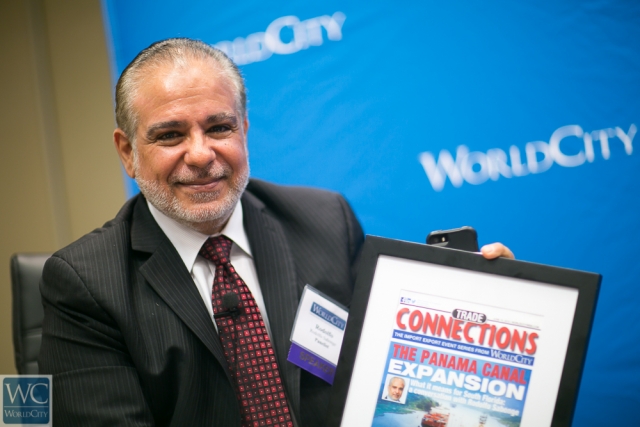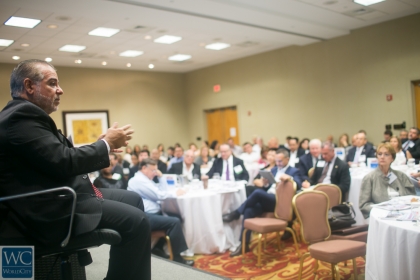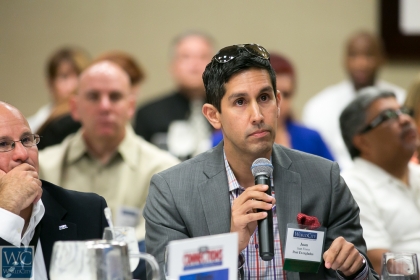Panama Canal expansion: How it may affect South Florida

Could economic development in Cuba help South Florida ports make the most of an expanded Panama Canal?
That is one likely scenario in the years to come, according to Rodolfo Sabonge, who spent nearly 30 years with the Panama Canal Authority, rising to executive vice president of planning and business development.
Sabonge, who now heads the Universidad del Caribe in the Dominican Republic, spoke about how the expanded Canal might affect South Florida and other U.S. ports at the WorldCity’s Trade Connections event on June 19 in Doral.
“In the particular case of Miami and its distance to Cuba, there are great opportunities,” he said. With interest rising in a free-trade zone at Cuba’s modern new seaport, said Sabonge – citing a recent Financial Times story, ships traversing the Canal could stop in Cuba to load and unload and then proceed to South Florida. “If that happened, you have the best near-sourcing possible.”
Sabonge’s insights came as the $5.2 billion Canal expansion enters its final phase. Builders recently filled both new locks with water both on the Atlantic and Pacific sides. The Canal’s new lane will be able to handle ships carrying 13,000 TEUs (or the equivalent of 13,000 20-foot containers). That’s more than double the current capacity.
PortMiami, along with other U.S. ports up and down the Eastern Seaboard, has been racing to attract the bigger ships. Miami now is deepening its channel to 50-feet to handle the larger ships, and last year, it opened a $1 billion tunnel to divert trucks from downtown to the Interstate-395 highway to prepare for extra cargo.
Still, said Sabonge, there’s no certainty an expanded Canal will boost trade volumes. That depends on many other factors, from shipping costs to trends in global production.
“The Canal does not create demand. It is the means to a shortcut,” Sabonge said. “If trade is not growing, the expansion of the Canal does not mean there will be more trade.”

Rodolfo Sabonge, who spent nearly 30 years with the Panama Canal Authority
And, indeed, trade growth presents a mixed picture, WorldCity data shows. Last year, U.S. trade with the world grew by 3.14 percent to $3.97 trillion, but that was the third straight year of annual growth less than 4 percent.
What’s more, said WorldCity CEO Ken Roberts, U.S. trade this year fell by nearly 4 percent through April.
“It’s unusual,” Roberts told an overflow audience at the event. “This year, trade is down without an external shock.”
To provide context, Sabonge explained that the Canal expansion was not planned because ships were getting bigger, but rather because the capacity was insufficient even for smaller vessels. Sometimes, ships had to wait up to week to cross. In that case, “it’s a shortcut no longer,” he said.
Meanwhile, shipping lines were seeking economies of scale by building larger vessels. Now, so many big ships have been built, there’s over-capacity. Shipping lines are battling each other to gain their share of customers and cargo, Sabonge said.
“If they need to fill those vessels, they will do anything they can,” he said, noting that many ships now operate at just 60 percent capacity.
To survive, many shipping lines are turning to alliances and setting up hubs, in the same manner as airlines. “They are negotiating their strategic locations of ports – they want to control their fate,” he said. “They are not into transportation any longer, they are into logistics.”
Shipping lines now are working “to control delivery of the cargo” for manufacturers like Toyota and Nike. That means planning ahead – including diversifying their routes to work around contingencies, said Sabonge.
A cargo shift from U.S. West Coast to East Coast ports?
What does that all mean for South Florida? asked Juan Flores, director intermodal programs at Port Everglades.
The answer isn’t so simple. It’s not likely that Long Beach and other U.S. West Coast ports will lose ships from Asia, Sabonge said. Cargo from those ports still will need to use truck or rail to reach its final destination. So, it will be a matter of comparing costs.
 On the positive side, Florida itself is a big market and growing. “It doesn’t make any sense to go north (to other U.S. East Coast ports) and then ship to Florida,” he said.
On the positive side, Florida itself is a big market and growing. “It doesn’t make any sense to go north (to other U.S. East Coast ports) and then ship to Florida,” he said.
Infrastructure also is key. Those ports with deep harbors, large cranes and an accessible distribution network will be ahead, said Sabonge.
But where Florida clearly has an edge is in its proximity to Cuba, should it become possible to develop free-zone operations there, he said.
“If it becomes an area of logistical and industrial development, then trade will be coming,” Sabonge said. “In the particular case of Miami, there is great opportunity.”
Trade Connections is one of five event series organized by WorldCity to bring together executives in greater Miami on international business topics. The trade series is sponsored by PortMiami, MIA, AmericanAirlines Cargo, HSBC and the Small Business Development Center at Florida International University’s School of Business.
Trade data analyzed by WorldCity also is available at www.worldcityweb.com and www.ustradenumbers.com, which offer more than 4,000 interactive stories examining data by ports, countries, customs districts and commodities.
The next Trade Connections event is set for Aug. 21.